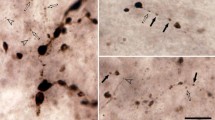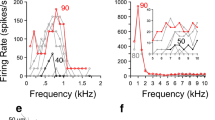Summary
The afferent auditory pathway in the region of the ventral cord ofLocusta migratoria has been studied electrophysiologically. Various recording, stimulating and surgical techniques have been used to infer the circuitry underlying the response patterns of the ventral-cord neurons ascending to the supraesophageal ganglion.
The stimuli used were artificial sounds (white noise and pure tones varying in frequency, intensity, duration, source direction and repetition rate). The responses of the auditory ventralcord neurons over the range of frequencies and intensities are described. Presentation of two sound stimuli occurring simultaneously or displaced in time permits the demonstration of inhibitory and subthreshold facilitatory influences which, with extracellular recording, cannot be observed directlyvia changes in membrane potential (Figs. 3 and 4).
On the basis of comparisons of responses before and after inactivation of a tympanal organ additional inferences are made concerning the relative contributions of the two tympanal organs to the formation of the response-patterns (Figs. 6, 11, 16, 21, 25).
The geometry, location and course of certain auditory ventral-cord neurons have been revealed by a combined recording and staining technique (Fig. 7); transection of connectives has made it possible to determine the origin of certain response-patterns and whether these change at various stations of the ventral cord as a result of corresponding synaptic input.
The results of such experiments, together with the knowledge of the course and location of endings of the tympanal receptor fibers in the ventral cord, have been used to construct sufficient connectivity diagrams for the ascending ventral-cord neurons (Figs. 8, 12, 17, 22, 26). The following general properties have been revealed: 1. Between receptor cells and ascending auditory ventral-cord neurons, as a rule, interneurons are interposed; this accounts for the observation that the postsynaptic structures of the ventral-cord neurons are for the most part situated outside the auditory neuropile. 2. Six basic connectivity patterns underlie the responses of the 14 ventral-cord neurons described; that is, the same response patterns are produced in sets of two or three ventral-cord neurons, owing to synaptic connectivities involving the same interneurons. The distinctions between the response patterns of the 14 neurons are interpretable as stemming from the addition of another interneuron to, or by elimination of a facilitatory or inhibitory connection from, the basic connectivity patterns.
Similar content being viewed by others
References
Adam, L.-J.: Neurophysiologie des Hörens und Bioakustik einer Feldheuschrecke (Locusta migratoria). Z. vergl. Physiol.63, 227–289 (1969)
Autrum, H., Schwartzkopff, J., Swoboda, H.: Der Einfluß der Schallrichtung auf die Tympanalpotentiale vonLocusta migratoria L. Biol. Zbl.80, 385–402 (1961)
Burrows, M., Rowell, C. H. F.: Connections between descending visual interneurons and metathoracic motoneurons in the locust. J. comp. Physiol.85, 221–234 (1973)
Gray, E. G.: The fine structure of the insect ear. Phil. Trans. B243, 75–94 (1960)
Hoyle, G., Burrows, M.: Neural mechanisms underlying behavior in the locustSchistocerca gregaria. II. Integrative activity in metathoracic neurons. J. Neurobiol.4, 43–67 (1973)
Hughes, G. M.: Neuronal pathways in the insect nervous system. In: The physiology of the insect central nervous system (J. E. Treherne, J. W. L. Beament, ed.), p. 79–112. New York: Academic Press 1965
Kalmring, K.: Akustische Neuronen im Unterschlundganglion der WanderheuschreckeLocusta migratoria. Z. vergl. Physiol.72, 95–110 (1971)
Kalmring, K., Rheinlaender, J., Rehbein, H. G.: Akustische Neuronen im Bauchmark der WanderheuschreckeLocusta migratoria. Z. vergl. Physiol.76, 314–332 (1972)
Kalmring, K., Rheinlaender, J., Römer, H.: Akustische Neuronen im Bauchmark der WanderheuschreckeLocusta migratoria. Der Einfluß der Schallrichtung auf die Antwortmuster. J. comp. Physiol.80, 325–352 (1972)
Kalmring, K., Römer, H., Rehbein, H. G.: Connections of acoustic neurons within the CNS of grasshoppers. Naturwissenschaften61, 454–455 (1974)
Michelsen, A.: The physiology of the locust ear. I. Frequency sensitivity if single cells in the isolated ear. Z. vergl. Physiol.71, 49–62 (1971)
Michelsen, A.: The physiology of the locust ear. II. Frequency discrimination based upon resonances in the tympanum. Z. vergl. Physiol.71, 63–101 (1971)
Michelsen, A.: The physiology of the locust ear. III. Acoustical properties of the intact ear. Z. vergl. Physiol.71, 102–128 (1971)
O'Shea, M., Rowell, C. H. F., Williams, J. L. D.: The anatomy of a locust visual interneurone; the Descending Contralateral Movement Detector. J. exp. Biol.60, 1–12 (1974)
Popov, A. V.: Electrophysiological studies on peripheral auditory neurons in the locust (in Russian). J. Evol. Biochem. Physiol.1, 239–250 (1965)
Popov, A. V.: Characteristics of activity of the central neurons in the auditory system of the locust. In: Problems of physiological acoustics (G. V. Gersuni, ed.): Mechanisms of hearing 6, p. 108–121. Leningrad: Nauka 1967
Popov, A. V.: Comparative analysis of sound signals and some principles of auditory system organization in cicads and Orthoptera. In: Modern problems of structure and function of the nervous system of insects (A. K. Voskresenskaja, ed.), p. 182–221. Leningrad: Nauka 1969
Popov, A. V.: Synaptic transformation in the auditory system of insects. In: Sensory process at the neuronal and behavioral levels (G. V. Gersuni, ed.), p. 301–320. New York: Academic Press 1971
Popov, A. V., Svetlogorskaja, I. D.: Ultrastructural organization of the auditory nerve in the locustLocusta migratoria (on the problem of the interaction between the receptors). J. Evol. Biochem. Physiol.7, 516–521 (1971)
Rehbein, H. G.: Experimentell-anatomische Untersuchungen über den Verlauf der Tympanalnervenfasern im Bauchmark von Feldheuschrecken, Laubheuschrecken und Grillen. Verh. dtsch. zool. Ges.66, 184–189 (1972)
Rehbein, H. G., Kalmring, K., Römer, H.: Structure and function of acoustic neurons in the thoracic ventral nerve cord ofLocusta migratoria (Acrididae). J. comp. Physiol.95, 263–280 (1974)
Rehbein, H. G., Kalmring, K., Schwartzkopff, J.: Verschaltung eines akustischen Neurons im Bauchmark vonLocusta migratoria. Naturwissenschaften61, 689 (1974)
Rheinlaender, J., Kalmring, K.: Die afferente Hörbahn im Bereich des Zentralnervensystems vonDecticus verrucivorus (Tettigoniidae). J. comp. Physiol.85, 361–410 (1973)
Seabrook, W. D.: The histology of the giant fibre system of the desert locust. Can. Ent.102, 1163–1169 (1970)
Seabrook, W. D.: An electrophysiological study of the giant fibre system of the locustSchistocerca gregaria. Canad. J. Zool.49, 555–560 (1971)
Suga, N.: Central mechanism of hearing and sound localization in insects. J. Insect Physiol.9, 867–873 (1963)
Suga, N.: Recovery cycles and response to frequency modulated tone pulses in auditory neurons of echolocating bats. J. Physiol. (Lond.)175, 50–80 (1964)
Suga, N., Katsuki, Y.: Central mechanism of hearing in insects. J. exp. Biol.38, 545–558 (1961)
Yanagisawa, K., Hashimoto, T., Katsuki, Y.: Frequency discrimination in the central nerve cords of locusts. J. Insect Physiol.13, 635–643 (1967)
Zhantiev, R. D., Chukanov, V. S.: Reaction of the auditory system ofGryllus bimaculatus (Orthoptera, Gryllidae) to intraspecific sound signals [in Russian]. Zool. J. (Moskau)51, 983–993 (1972)
Author information
Authors and Affiliations
Additional information
Part of the program of the Sonderforschungsbereich 114 (Bionach) Bochum; supported by the Deutsche Forschungsgemeinschaft.
Rights and permissions
About this article
Cite this article
Kalmring, K. The afferent auditory pathway in the ventral cord oflocusta migratoria (Acrididae). J. Comp. Physiol. 104, 103–141 (1975). https://doi.org/10.1007/BF01379455
Received:
Issue Date:
DOI: https://doi.org/10.1007/BF01379455




